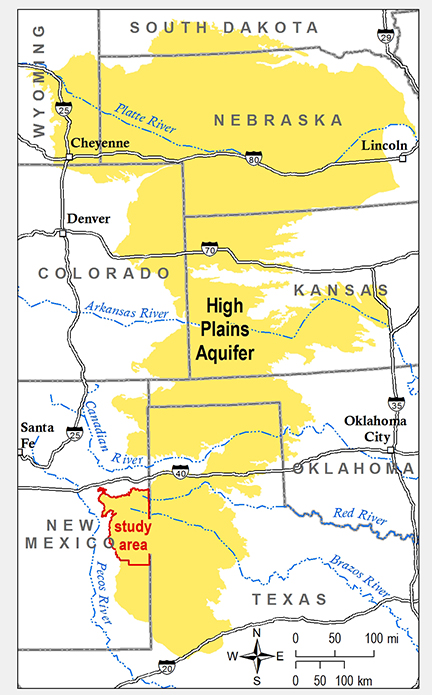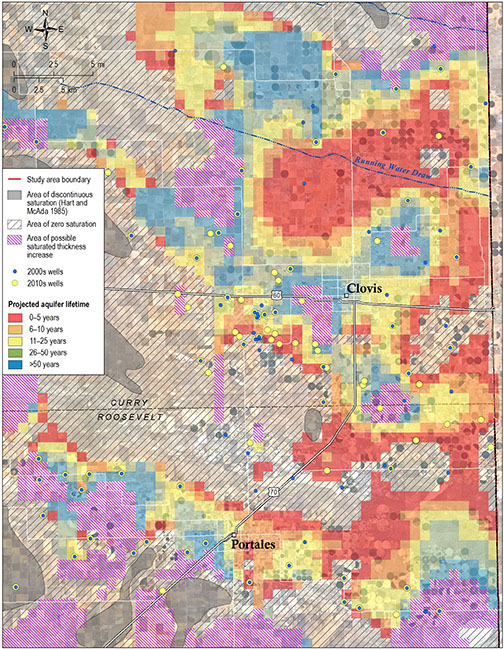Two Bureau Scientists Win GSA Award for High Plains Aquifer Research
May 20, 2021
Geoff Rawling and Alex Reinhart published study about dwindling groundwater supply
Socorro, N.M. - New Mexico Bureau of Geology Senior Field Geologist Dr. Geoffrey Rawling and New Mexico Tech Assistant Professor Dr. Alex Rinehart will receive the John C. Frye Environmental Geology Award at the Geological Society of America annual meeting for their paper “Lifetime projections for the High Plains Aquifer in east-central New Mexico.”
 This award is presented annually to the best paper on environmental geology published
either by one of the state geological surveys or by the Geological Society of America
within the last three years.
This award is presented annually to the best paper on environmental geology published
either by one of the state geological surveys or by the Geological Society of America
within the last three years.
“To have an organization like GSA recognize it, it’s an honor,” Rawling said.
The High Plains Aquifer (pictured at right), sometimes called the Ogallala Aquifer, stretches across multiple western states, from New Mexico to Texas and Oklahoma, and north all the way to South Dakota. The bulletin published in 2017 used water level data collected in thousands of wells in Curry and Roosevelt Counties from 1950 to 2016 to look at changes the level of the water table over time and calculate the rate of water level decline in the aquifer over that period.
This decline rate was then projected into the future to see when the water level in the aquifer would fall below where it can sustain high capacity irrigation wells, the 30-foot saturated thickness, and the level where it can sustain municipal and domestic wells, the fully dewatered point. This can be considered the worst-case scenario “useable lifetime” of the aquifer. The projections of water table decline initially generated alarm amongst decision-makers.
The study area of the High Plains Aquifer encompasses the cities of Clovis and Portales. The largest sector of the regional economy is agriculture, including both crop and dairy production. With no surface water available, agricultural, industrial, municipal and domestic water production is entirely dependent on groundwater.
 Groundwater mining, where groundwater is pumped from an aquifer faster than it can
be replaced by recharge from surface water, is straining water resources in the region.
Water-levels have been declining on average by about 1.5 feet per year since 1950.
This rate is about 90 times greater than the rate of groundwater recharge.
Groundwater mining, where groundwater is pumped from an aquifer faster than it can
be replaced by recharge from surface water, is straining water resources in the region.
Water-levels have been declining on average by about 1.5 feet per year since 1950.
This rate is about 90 times greater than the rate of groundwater recharge.
“If you know how much saturated thickness remains, which you do because we had the water table surface at any time and we know the bottom of the aquifer, and you have the decline rate, then you just divide and you get a time,” Rawling said.
Results suggest that, should pumping continue at the rate it has in the past, large capacity irrigation wells will be unusable within a few tens of years or less. Indeed, most of southeast Curry and northeast Roosevelt Counties are already below the 30-foot saturated thickness level needed to support these wells.
If the irrigation wells shut down below the 30-foot saturation point, it would prolong the life of lower capacity municipal and domestic wells. However, the study found that even these lower capacity wells would only be able to operate for one or two more decades.
While dire, these projections reflect past aquifer decline rates. Should changes in pumping in the future reduce the rate of aquifer decline, it could extend the life of the High Plains Aquifer. Towards that end, decision-makers have used the results from this study to plan a new water source, the Ute pipeline project, which will supply surface water from Ute Reservoir to the region.
Crucially, this study, and the policy decisions it supports, would not be possible without historical water level measurements in wells.
“Water level data is really important. It’s expensive to get and time consuming and it requires the cooperation of the public, but if you can’t measure it and you don’t have quantitative data, you have no idea what’s going on,” Rawling said. “You can’t regulate groundwater, you can’t do studies like this … I think a lot of people in New Mexico now realize how important it is.”
Funding for this project was provided by the City of Clovis, Curry County, and Eastern New Mexico Water Utility Authority.
– NMT –